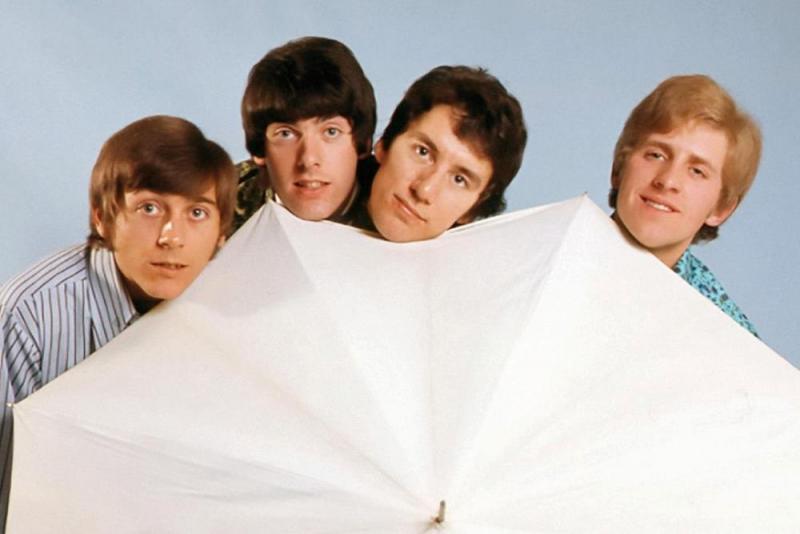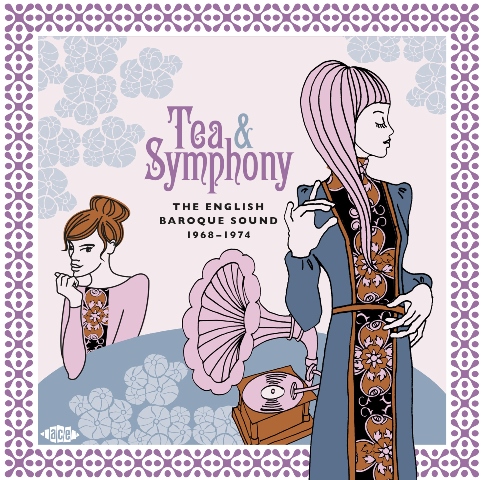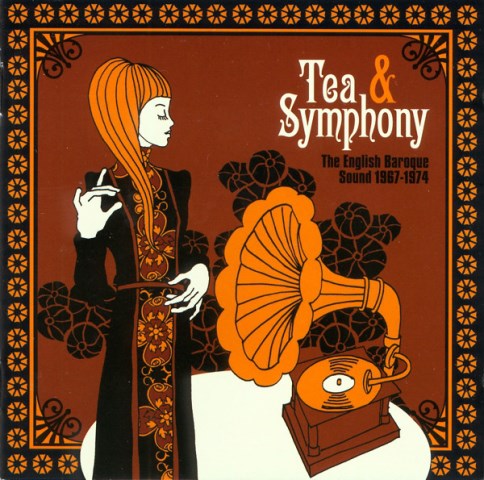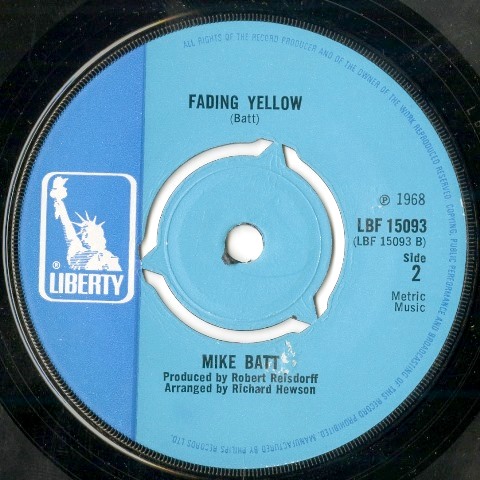Reissue CDs Weekly: Tea & Symphony - The English Baroque Sound 1968-1974 | reviews, news & interviews
Reissue CDs Weekly: Tea & Symphony - The English Baroque Sound 1968-1974
Reissue CDs Weekly: Tea & Symphony - The English Baroque Sound 1968-1974
Stylish, Saint Etienne-compiled digest of what else was going on when pop went glam, heavy and prog

When it was issued in May 1968, “Fading Yellow” attracted no attention. It couldn’t have as it was the B-side of “Mr. Poem”, Mike Batt’s poor-selling debut single. The top side was good, very 1968 and along the lines of whimsical 45s like Donovan’s “Jenifer Juniper” or Marty Wilde’s “Abergavenny” but wasn’t a hit.
However – as deep-digging collectors later discovered – “Fading Yellow” was the true treasure. Over three minutes 40 seconds Batt, who then worked as an A&R man at his label Liberty, fashioned a delicate, misty evocation of isolation; of a life where it was impossible to take part in what’s going on in the wider world. Mike Batt had turned Miss Havisham into a Sixties pop song.
 The afterlife of “Fading Yellow” formally began in 1995, when a grey area Swedish label issued the compilation album Fading Yellow. Batt’s B-side was included. The collection’s sub-title was “Timeless Pop-Sike & Other Delights”. Then, in 2002, it was overhauled for CD (this version was released as a double album in 2012). Five years on from 2002, Mike Batt’s gone-overground track cropped up a third time on Tea & Symphony – The English Baroque Sound 1967–1974, another CD comp. That one, though legit, barely hit the shops as the label it was on went under.
The afterlife of “Fading Yellow” formally began in 1995, when a grey area Swedish label issued the compilation album Fading Yellow. Batt’s B-side was included. The collection’s sub-title was “Timeless Pop-Sike & Other Delights”. Then, in 2002, it was overhauled for CD (this version was released as a double album in 2012). Five years on from 2002, Mike Batt’s gone-overground track cropped up a third time on Tea & Symphony – The English Baroque Sound 1967–1974, another CD comp. That one, though legit, barely hit the shops as the label it was on went under.
Now, Tea & Symphony – The English Baroque Sound 1968–1974 has arrived, and with a front cover image reconfiguring that of its 2007 predecessor. Once again, “Fading Yellow” is included. Saint Etienne’s Bob Stanley, the compiler of both Tea & Symphony sets, has pointed out that the words “fading yellow” have become akin to an after-the-fact genre classification – like acid folk or freakbeat. What was in 1995 a strand of pop psychedelia (“Pop-Sike”) has been given a life of its own.
 In the new Tea & Symphony’s liner notes (pictured left: its 2007 predecessor), Stanley says the style “made great use of string quartets, woodwind, and summer-into-autumn melancholy. This was a sound informed by the Zombies’ Odessey And Oracle, the weighty chamber pop of the Bee Gees and Scott Walker, with a contemporary dash of Crosby, Stills & Nash harmony. The urtexts had all been Paul McCartney’s: the bereft strings of ‘Eleanor Rigby’; the buttoned-up, parlour arrangement of ‘For No One’; ‘Your Mother Should Know’s' sepia nostalgia and insistent piano; the entire acoustic corner of The White Album. Just add harpsichord and a cor anglais to the mix, and there it was.”
In the new Tea & Symphony’s liner notes (pictured left: its 2007 predecessor), Stanley says the style “made great use of string quartets, woodwind, and summer-into-autumn melancholy. This was a sound informed by the Zombies’ Odessey And Oracle, the weighty chamber pop of the Bee Gees and Scott Walker, with a contemporary dash of Crosby, Stills & Nash harmony. The urtexts had all been Paul McCartney’s: the bereft strings of ‘Eleanor Rigby’; the buttoned-up, parlour arrangement of ‘For No One’; ‘Your Mother Should Know’s' sepia nostalgia and insistent piano; the entire acoustic corner of The White Album. Just add harpsichord and a cor anglais to the mix, and there it was.”
The new release’s most well-known tracks are “I Can't Let Maggie Go” by The Honeybus and former Zombie Colin Blunstone’s “Say You Don't Mind”, each a rich example of this genus of British pop. Alongside them, the most familiar names are Bill Kenwright (the future football club chairman and theatre man), Nirvana, the post-Peter & Gordon Gordon Waller and Clifford T. Ward. Vigrass & Osborne’s original version of “Forever Autumn”, later a hit for Justin Hayward, is also heard as is, of course, "Fading Yellow". Matthew Bones, Erasmus Chorum, Sunchariot and Tandem are more obscure. None of the 22 tracks on this year’s Tea & Symphony are clunkers. If a primer in this sound is needed, this is it. Even so, odd cuts stand apart.
 “Mary Jane” is a 1972 B-side by a North London band named Erasmus Chorum. The sparse arrangement centres on swelling and swooning strings, moody Hammond organ, acoustic guitar and oddly fiddly drums. The melody is affectingly doleful. The lead voice is very strange: wobbly and pitched above than the singer’s range. Like a very extreme version of Audience’s Howard Werth. A deeply intense experience.
“Mary Jane” is a 1972 B-side by a North London band named Erasmus Chorum. The sparse arrangement centres on swelling and swooning strings, moody Hammond organ, acoustic guitar and oddly fiddly drums. The melody is affectingly doleful. The lead voice is very strange: wobbly and pitched above than the singer’s range. Like a very extreme version of Audience’s Howard Werth. A deeply intense experience.
Gordon Waller’s self-penned “The Seventh Hour” is less strange but also on its own path. The 1968 B-side of his third solo single is clearly influenced by Jimmy Webb’s aural dramas, but lyrically is a very personal reflection on newly becoming a father. If it had been chosen as a plug side, perhaps its theme may have chimed with buyers? But like so many of these tracks, it was effectively buried.
Beyond rescuing lost gems, Tea & Symphony – The English Baroque Sound 1968–1974 is a coherent, consistent listen and sequenced with an ebb and flow irrespective of the familiarity or obscurity of what’s collected. Four tracks are reprised from its 2007 predecessor (as are odd phrases in the liner notes) but it comes across as a fresh compilation. As such, it’s a valuable reminder that hindsight may be needed before musical styles are identified.
- Next week: the Hank Williams book and CD set Pictures From Life’s Other Side – The Man and His Music in Rare Photos and Recordings
- More reissue reviews on theartsdesk
- Kieron Tyler’s website
Share this article
The future of Arts Journalism
You can stop theartsdesk.com closing!
We urgently need financing to survive. Our fundraising drive has thus far raised £49,000 but we need to reach £100,000 or we will be forced to close. Please contribute here: https://gofund.me/c3f6033d
And if you can forward this information to anyone who might assist, we’d be grateful.

Subscribe to theartsdesk.com
Thank you for continuing to read our work on theartsdesk.com. For unlimited access to every article in its entirety, including our archive of more than 15,000 pieces, we're asking for £5 per month or £40 per year. We feel it's a very good deal, and hope you do too.
To take a subscription now simply click here.
And if you're looking for that extra gift for a friend or family member, why not treat them to a theartsdesk.com gift subscription?
more New music
 Album: Mulatu Astatke - Mulatu Plays Mulatu
An album full of life, coinciding with a 'farewell tour'
Album: Mulatu Astatke - Mulatu Plays Mulatu
An album full of life, coinciding with a 'farewell tour'
 Music Reissues Weekly: Sly and the Family Stone - The First Family: Live At Winchester Cathedral 1967
Must-have, first-ever release of the earliest document of the legendary soul outfit
Music Reissues Weekly: Sly and the Family Stone - The First Family: Live At Winchester Cathedral 1967
Must-have, first-ever release of the earliest document of the legendary soul outfit
 Album: Robert Plant - Saving Grace
Mellow delight from former Zep lead
Album: Robert Plant - Saving Grace
Mellow delight from former Zep lead
 Brìghde Chaimbeul, Round Chapel review - enchantment in East London
Inscrutable purveyor of experimental Celtic music summons creepiness and intensity
Brìghde Chaimbeul, Round Chapel review - enchantment in East London
Inscrutable purveyor of experimental Celtic music summons creepiness and intensity
 First Person: Musician ALA.NI on how thoughts of empire and reparation influenced a song
She usually sings about affairs of the heart - 'TIEF' is different, explains the star
First Person: Musician ALA.NI on how thoughts of empire and reparation influenced a song
She usually sings about affairs of the heart - 'TIEF' is different, explains the star
 Album: NewDad - Altar
The hard-gigging trio yearns for old Ireland – and blasts music biz exploitation
Album: NewDad - Altar
The hard-gigging trio yearns for old Ireland – and blasts music biz exploitation
 Album: The Divine Comedy - Rainy Sunday Afternoon
Neil Hannon takes stock, and the result will certainly keep his existing crowd happy
Album: The Divine Comedy - Rainy Sunday Afternoon
Neil Hannon takes stock, and the result will certainly keep his existing crowd happy
 Music Reissues Weekly: Robyn - Robyn 20th-Anniversary Edition
Landmark Swedish pop album hits shops one more time
Music Reissues Weekly: Robyn - Robyn 20th-Anniversary Edition
Landmark Swedish pop album hits shops one more time
 Album: Twenty One Pilots - Breach
Ohio mainstream superstar duo wrap up their 10 year narrative
Album: Twenty One Pilots - Breach
Ohio mainstream superstar duo wrap up their 10 year narrative
 Album: Ed Sheeran - Play
A mound of ear displeasure to add to the global superstar's already gigantic stockpile
Album: Ed Sheeran - Play
A mound of ear displeasure to add to the global superstar's already gigantic stockpile
 Album: Motion City Soundtrack - The Same Old Wasted Wonderful World
A solid return for the emo veterans
Album: Motion City Soundtrack - The Same Old Wasted Wonderful World
A solid return for the emo veterans
 Album: Baxter Dury - Allbarone
The don diversifies into disco
Album: Baxter Dury - Allbarone
The don diversifies into disco

Add comment